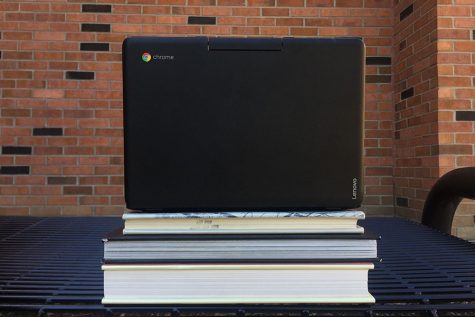Old school meets digital
With the introduction of Chromebooks to the Iowa City Community School District in 2017, there has been an increase in the use of online textbooks in classrooms, causing debate over the future of educational resources.
Over the past ten years, access to technology and online resources has increased greatly in schools. Classrooms across the Iowa City Community School District have gone from using chalkboards and whiteboards to smartboards and chromebooks.

With the addition of Chromebooks, the district has been in transition between print and online textbooks.
The district has also given students and parents enhanced digital resources like Powerschool and, more recently, Canvas. One of the most helpful additions for many students has been access to electronic textbooks.
Since e-textbooks can be accessed by computers, they do not cause problems like taking up valuable space and weighing down backpacks, but they are not without shortcomings. Since many classes already have complimentary e-textbooks it begs the question of whether the district still needs hard copy textbooks at all.
For social studies teacher Alexei Lalagos, the addition of e-textbooks has been beneficial to his students. For him, the ease of e-textbooks has also helped the flow of class.
“It’s really nice to make sure that nobody can forget their book in their locker or at home,” Lalagos said.“If I need to do a quick activity that references the book I can get in and out of that,” said Lalagos.
He added that not everything can be done better digitally, and students can often prefer paper copies.
“What I’ve found is a lot of students have requested paper copies for certain activities,” Lalagos said. “When you’re looking at a screen and writing it’s just easier to write something down.”
On the other hand, Nicole Trout ‘21 finds reliability issues with using e-textbooks. “I don’t like online textbooks since chromebooks can crash and I can forget my passwords,” said Trout.
For her, e-textbooks would need to be more dependable and easy to access if they were to fully replace hard copy textbooks.
Research shows that learning from digital sources could be worse for information retention than print sources. According to a study conducted by “The Journal of Experimental Education,” students were able to recall key points and main ideas better from print than digital sources. Quite the contrary, students were more confident in their level of comprehension when they used digital sources and actual performance on tests among both groups were similar.
On top of this, a study conducted by researchers at the Harvard-Smithsonian Center for Visual Learning indicated that e-readers can be more effective for dyslexic students. If the district were to implement these online learning resources to classes it could potentially help the progression of students with dyslexia substantially.
As for now, the impact of e-textbooks in the classroom is undeniable.
“In class, I see a lot [of] kids pulling up their textbook on their chromebook or laptop and a lot of times they’re following along with what’s going on in class at the same time,” said Lalagos. “Anywhere you have internet connection, or offline if you download the textbook as a pdf, you can can have access to the textbook.”
Thus presents the greatest strength of technology: convenience. Although there are differing opinions over e-textbooks in the classroom, their impact and convenience have reshaped the classroom learning environment for students.
Your donation will support the student journalists of West High School. Your contribution will allow us to purchase Scholarship Yearbooks, newsroom equipment and cover our annual website hosting costs.

Ken Wilbur is a senior at West and a third-year staffer on West Side Story. While not recording podcasts or writing articles, Ken can be found running...

Mohammedhilal Al-Ani is a Sophomore at West this is his first year in staff. He is a photographer.


